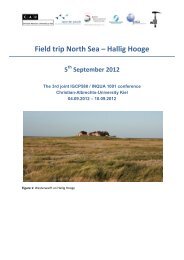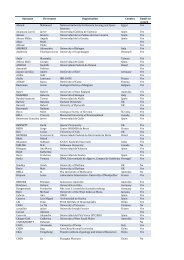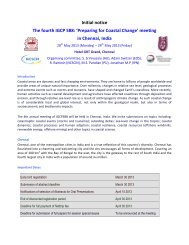Conference program and abstracts - Coastal-Change.Org
Conference program and abstracts - Coastal-Change.Org
Conference program and abstracts - Coastal-Change.Org
Create successful ePaper yourself
Turn your PDF publications into a flip-book with our unique Google optimized e-Paper software.
Tsunami history along the coastline of Oman (Arabian<br />
Peninsula)<br />
Gösta Hoffmann 1,2 , Klaus Reicherter 2 , Christoph Grützner 2 , Magdalena<br />
Rupprechter 1<br />
1<br />
German University of Technology, Department of Applied Geosciences,<br />
PO Box 1816, PC 130, Muscat, Oman (goesta.hoffmann@gutech.edu.om)<br />
2<br />
Institute of Neotectonics <strong>and</strong> Natural Hazards, RWTH Aachen University,<br />
Lochnerstr. 4-20, 52056 Aachen, Germany<br />
ABSTRACT<br />
The Sultanate of Oman is situated in the north-eastern part of the Arabian<br />
Peninsula. The Arabian Plate is characterized by a northward movement<br />
forming a continent-continent collision zone in the west <strong>and</strong> the Makran<br />
Subduction Zone (MSZ) in the east. The MSZ is known to have produced<br />
tsunamigenic earthquakes in the past. The last event occurred in 1945.<br />
We aim at reconstructing paleo-tsunami in order to constrain recurrence<br />
intervals. We use historical, geological <strong>and</strong> archaeological data to<br />
achieve this goal.<br />
We reconstruct the tsunami event of 28 th November, 1945 by utilizing<br />
historical information. Furthermore, we carried out interviews with<br />
eyewitnesses. This information allows us to reconstruct the impact of the<br />
tsunami waves around the shores of the northern Indian Ocean. The<br />
coastlines of Pakistan <strong>and</strong> India were severely affected; the impact along<br />
the Omani coastline was minor.<br />
Geological evidence for paleo-tsunami is mainly seen in block <strong>and</strong><br />
boulder deposits along the coast. The largest of these blocks exceed 100<br />
tons in mass <strong>and</strong> indicate that the tsunami experienced in 1945 was by far<br />
not the worst-case scenario.<br />
We analyzed a bronze-age coastal settlement in Ras al Hadd (HD-6).<br />
Archaeological evidence proves 2 settlement phases. The archaeological<br />
site is located directly on the shores of the Indian Ocean.<br />
Geomorphological, sedimentological <strong>and</strong> dating evidence is presented<br />
that support the hypothesis that the settlement was inundated by an<br />
extreme wave event around 2800 BC during the first settlement phase.<br />
Whether or not this was a tsunami is currently under research.<br />
The Fourth IGCP 588: PREPARING FOR COASTAL CHANGE 5





